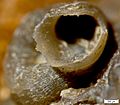Lophophore facts for kids
The lophophore is a special body part that helps certain water animals eat. It's like a unique feeding tool found in four main groups of animals: Brachiopods, Bryozoa, Entoprocta, and Phoronida. All these animals live in water.
What is a Lophophore?
Think of a lophophore as a ring of tiny, hair-like tentacles that surround the animal's mouth. These tiny hairs are called cilia. The lophophore often looks like a horseshoe or is coiled up.
For some animals, like phoronids, their lophophore is easy to see. But for others, like brachiopods, you have to open their shells wide to get a good look at it.
How Lophophores Help Animals Eat
The lophophore is positioned around the mouth and works like a net to catch food particles floating in the water. This way of eating is called "suspension feeding." The tiny cilia on the tentacles create currents that pull food towards the mouth.
Inside these animals, their gut (digestive system) is shaped like a "U." The mouth is located in the middle of the lophophore. For most of these animals, the anus (where waste leaves the body) is also near the front, above the mouth.
- In bryozoans, the anus is outside the lophophore's ring.
- In entoprocts, the anus is inside the lophophore's ring.
- Interestingly, some brachiopods don't even have an anus!
Images for kids
-
An extinct animal with a lophophore: a Devonian microconchid fossil from Michigan.
See also
 In Spanish: Lofóforo para niños
In Spanish: Lofóforo para niños




